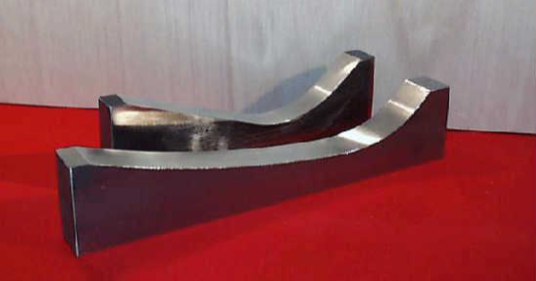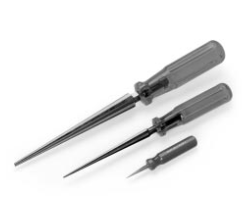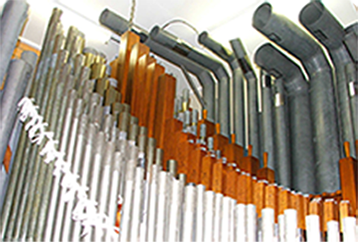Ever hear the term "Tonal Finishing?" We attempt to sort it all out here.
Just what is "Tonal Finishing"? It is a process that has been around for centuries and is practiced by organ builders worldwide. Also known as "voicing" or "regulating", the process is meant to meld together the sounds of the various pipes and ranks in the instrument to create a series of gorgeous ensembles.
Tonal finishing takes place at the end stages of building or refurbishing an organ, and is clearly the most important step in achieving perfection. An organ cannot be properly regulated at the factory. The effects of the size of the organ, the resonance of the chambers, the size of the venue, and the acoustics of the building all come into play.
Once the initial installation or refurbishment of an organ is complete, what you really have is sets (ranks) of tin, wood, and sometimes brass whistles operated by an air turbine, and controlled by a console. An exact tuning of every pipe and rank in the instrument will enable the playing of music, but what will the music sound like? Unless you are unusually lucky, Not Much!
In addition to regulating each rank, note by note, to ensure even volume within the rank, the volume or power must be adjusted so that the ranks blend and complement each other, and one does not drown the other out. Building a set of "terraced” ensemble volume levels in the organ that are each coherent, yet work together to build larger ensembles, is the ultimate goal in organ tonal finishing. In addition, the speech or tonal color of many ranks can be adjusted, particularly the reeds, to vary the brightness of the tone from mellow to raspy. Ranks can also be "contoured" so that the sound varies from the bass register up to the treble.
Voicing Reed Pipes:
Reeds have two major parts that determine the overall tone and volume. The first is the resonator, the familiar pipe tube that is sometimes cylindrical (clarinets, krumets), sometimes conical (tubas, trumpets), and sometimes capped (vox humanas, French horns). The second, and hidden part, is the reed (also known as the “tongue”) and the shallot on which it is held. This assembly is at the bottom of the pipe (resonator) and is contained in the block where the resonator ends. The mechanism of reed and shallot is mounted into the block and housed in the boot of the pipe, which can be removed to allow the technician to work on the reed.
The sound of a reed pipe is the result of a combination of factors including the shape and style of the resonator, its harmonic length, and the metal out of which it is made. (For example, Wurlitzer used brass for its trumpet resonators because they felt that it had a better, more orchestral sound.) Also contributing to the sound of the pipe is the reed and shallot. The reed is a thin piece of metal (brass or phosphor bronze) whose thickness is measured in thousandths of an inch. (The reed takes its name from the bamboo reed used in the common clarinet or saxophone.) The shallot is the hollow brass tube with a flattened face and an opening in that face against which the reed vibrates. The physical configuration of the shallot affects the type of sound produced as does the shape of the reed. A thinner reed tongue generally gives a brighter sound. A thicker tongue, especially one with added weights (like a high pressure tuba), gives a darker sound. The amount the reed moves away from, and back to the shallot in its vibration is the reed's amplitude and causes the pipe to be either louder or softer. The greater the amplitude of the reed, the louder the pipe will be when it is in pitch. Adding "curve" or decreasing "curve" at the bottom of the reed, changes its amplitude. The voicer adjusts the reed with a specially shaped tool called a curving block (a heavy piece of metal with one or several different curve forms in it). He/she puts the reed on the block, and applies "curve" (or decreases it) by rubbing the reed with a burnishing tool.

Curving Blocks
The tuning wire, which moves up and down the reed to allow for tuning, also allows the amplitude to be changed to some extent. The further down the wire is on the reed, the less amplitude and vice versa. Changing the amplitude also changes the pitch or frequency of the reed however, so the voicer, when changing the volume of the pipe, will first set the volume with the amount of curve or the tuning wire, either increasing (louder) or decreasing (softer) the amplitude of the reed, and then tune the pipe with the slide or scroll at the top of the resonator to either lengthen or shorten the resonator to put it in pitch. The shorter the pipe, the higher the pitch, the longer the pipe, the lower the pitch. Once the pipe is voiced, the process of tuning the pipe is usually just a matter of moving the tuning wire slightly to allow the reed to be put back where the voicer wanted it when he tuned and voiced it originally. Voicers leave marks on reed pipes to help put things back where they wanted it. These marks are usually just small lines made with a sharp knife. There is a voicer mark to indicate where the slide at the top of the resonator should be, and also another one on the shallot to tell how far in the shallot is to be inserted in the block of the pipe. (Note: Some reed pipes, like a Wurlitzer brass trumpet, have no scrolls or slides. On these pipes the whole body of the pipe slides up a small tube at the base and is held in place by a small clamp. Still other pipes, like a Wurlitzer English post horn have no resonator adjustment at all. On these pipes all the changes to volume must be done with the reed alone.)
Reed voicing is complicated and involves delicate parts. Reeds are easily bent, twisted or creased by well-meaning amateurs. It's best to leave the process to the experts or at least to someone who is very experienced. Those who wish to learn the craft should find a professional to study with, and practice on some old unwanted pipes from a broken set.

Voicing Flue Pipes:
A flue pipe is really just a whistle, and as such responds to greater or less wind pressure to determine its volume. Flue pipes include the string, diapason and tibia/flute ranks in the organ. The way a voicer works on a flue pipe is much less complicated than on a reed pipe. Although the upper lip, the languid (the flat bottom of the mouth area inside the pipe), and windway (the little slot that allows the air to pass up from the bottom of the pipe and blow across the upper lip) are sometimes adjusted for proper speech, the majority of voicing is done just with the toe hole at the very bottom of the pipe - the larger the hole, the more wind and the greater the pressure in the pipe, making a sound wave with a bigger amplitude, therefore creating a greater sound volume. The voicer has a special tool for making the size of the hole bigger (a toe reamer) and one for hammering the toe closed (a cone shaped hammer that looks like an egg cup).


Pipe Toe Reamers
Pipe Toe Cones
Wooden pipes, like tibias and concert flutes, have a lead toe to allow changes to be made one way or the other. If you open it too much, you can just hammer it closed again. Some large wood pipes have a built-in adjustment gate at the bottom so that you don't have to remove the pipe to change the amount of wind. When you change the opening in the toe, you have to retune the pipe by making it longer or shorter accordingly. For instance, if you blow into a whistle and increase the pressure, the pitch goes up. The same thing happens with an organ pipe. So when you open the toe, you need to make the pipe longer (with a slide at the top or stopper if the pipe is a stopped pipe) to compensate to lower the pitch. In the inverse, if you decrease the amount of opening, lowering the pressure in the pipe, you have to shorten the pipe to raise the pitch.
Voicing is an extensive process of trial and error to determine what characteristics blend together best for the particular instrument being voiced. Voicers spend years learning the process, and obtaining an experienced professional for your organ is the key to success. But, the world of music is driven by personal taste, and even professional voicers can disagree as to the best sound.
Theatre Organs have an additional set of variables that give us that “lush sound that wraps itself all around you”, namely the tremulants. Different ranks can be controlled by different tremulant mechanisms. The speed and depth of tremulation can be adjusted from a light trem to a deep vibrato. Again, personal taste enters the mix.
Finally, some organs are built with "celeste" ranks. A celeste is the duplication of an existing rank. Celestes can be found in several pipe ranks including string, flute, quintadena, and dulciana. The celeste rank is tuned slightly sharp or slightly flat relative to its twin. When a "celeste" stop is chosen, both ranks play, creating a unique delightful sound. Of course, that sound must meld with the rest of the ensemble!
Bottom line: When a Theatre Pipe Organ installation is complete and the instument tuned, are you done? Absolutely not!! Voicing by a professional is necessary to bring the instrument to its full potential, creating a concert caliber installation.










